The period between the late autumn and the arrival of the first snow is generally not peak tourist season in many destinations, which is perhaps why Shimano Gravel Alliance rider Dalila Lecky enjoys it so much. At the end of last year, she headed off for a short gravel getaway to the island of Sicily where she biked, hiked, went ghost hunting and searched for traction in Mount Etna’s fine volcanic gravel.

As we flew in, I feared I had chosen a seat on the wrong side of the plane and wouldn't get that first glimpse at the mountain I would be exploring over the next few days. But, by luck, or maybe by design, we overshot the island and turned a full 180°, allowing all the passengers a full view of the towering peak. Some snow had already been deposited on the upper slopes but not enough to have started the ski season or to turn this into a very different kind of cycling trip.
I got a transfer from the airport to the town in which I would base myself for the next few days, Zafferana Etnea. When planning this trip, it looked like the ideal location for exploring the trails of Etna at this time of year. On the way, my driver, Enzo, gave me a quick run-through of the more recent volcanic eruptions and pointed out various buildings that had been damaged in an earthquake in 2019. We also discussed food, the weather and street dogs.

Walking around the town later, black sand crunched under my feet with every step, a reminder that this mountain is one of the most active volcanoes in the world. In fact, it had been erupting only a week or so before my trip and left this volcanic dust all over the area. I picked up lunch from a little pasticceria – a couple of arancini, of course.

From the town square, I could see the peak of Etna puffing away, biding its time until the next dramatic eruption, and in the opposite direction the glistening waves of the Mediterranean Sea, all with a backdrop of blue skies and sunshine. This wasn't exactly the weather I had expected. Although Sicily is reasonably southern, December usually brings some of the most rainy and windy weather of the year and it's not uncommon for there to be snow from about halfway up the mountain to the top.
After lunch, the day's 3 AM start finally caught up with me so I headed to my room for a nap, followed by the rebuilding of my bike. Whilst putting together my bike I realised I was missing a crucial stem bolt that had been lost in transit. I'd have to make a quick trip to the local hardware store in the morning, an M5 bolt couldn't be too hard to source, surely.
After dinner, I headed straight to my room, but I couldn't sleep. Perhaps it was my earlier nap, or maybe all of my excitement about getting to explore some new trails. I eventually nodded off at about 1 AM. It wasn't ideal but I'd gotten by on far less when I rode the Granguanche gravel audax.
I also realised that I'd need to come up with an alternative plan for the first day of riding due to the time lost in procuring a replacement bolt. Fortunately, I had a shorter ride already loaded onto my Hammerhead cycle computer - my bad weather and/or volcanic eruption backup plan. This involved a scenic ride to the coast followed by a stunning river and rock formation before returning to my hotel via the foothills of Etna – a nice little warm-up ride.
By 10 AM I’d successfully sourced and fitted a replacement stem bolt. komoot was predicting a 5-hour ride time, and I knew that with photo stops and my planned mid-ride hike, this could become much longer. Still, having forgotten to mount my lights, I'd have to be back by sunset, which I learned was approximately 4.40 PM.
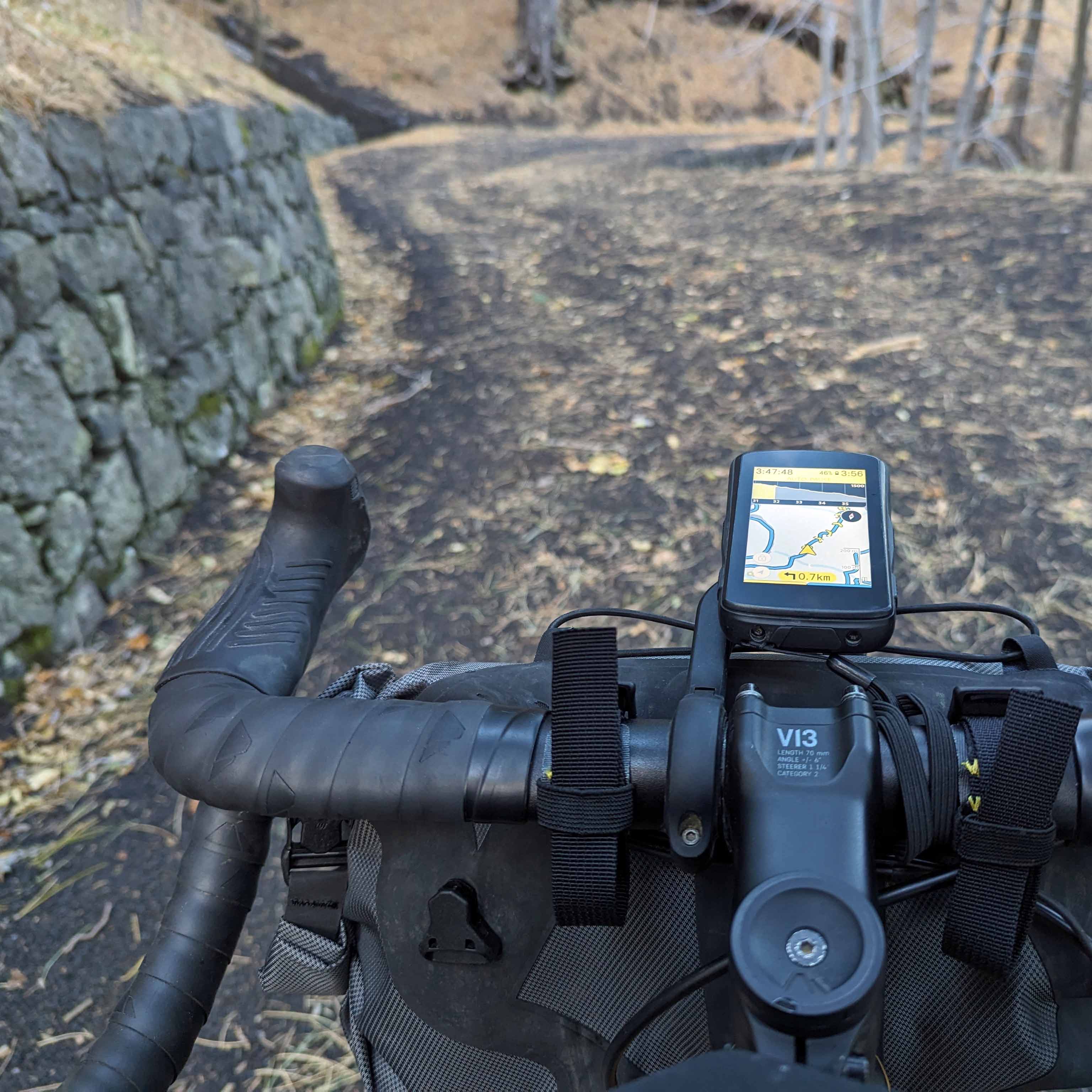
The first bit of off-road very quickly turned into a tiny section of hike-a-bike. Hideously overgrown bushes and super loose volcanic gravel threatened to chuck me off the bike, so I accepted defeat and walked for about a minute and then it was back onto the rideable stuff.
All day, a small voice in the back of my mind reminded me to keep an eye out for dogs. Enzo had warned me to be vigilant and various internet reports confirmed that it was a significant concern. Fortunately, every aggressive dog I encountered was kept behind a fence, all except one. It almost caught me off guard, so I did the main thing I had learned whilst battling dogs every day in Ecuador, I got off the bike and firmly delivered: ‘No! Go home.’ Instantly, the street dog turned into a scaredy cat. I continued walking for about fifty metres or so, the dog timidly followed me at first but then thought better of it, so I remounted and continued on my journey.
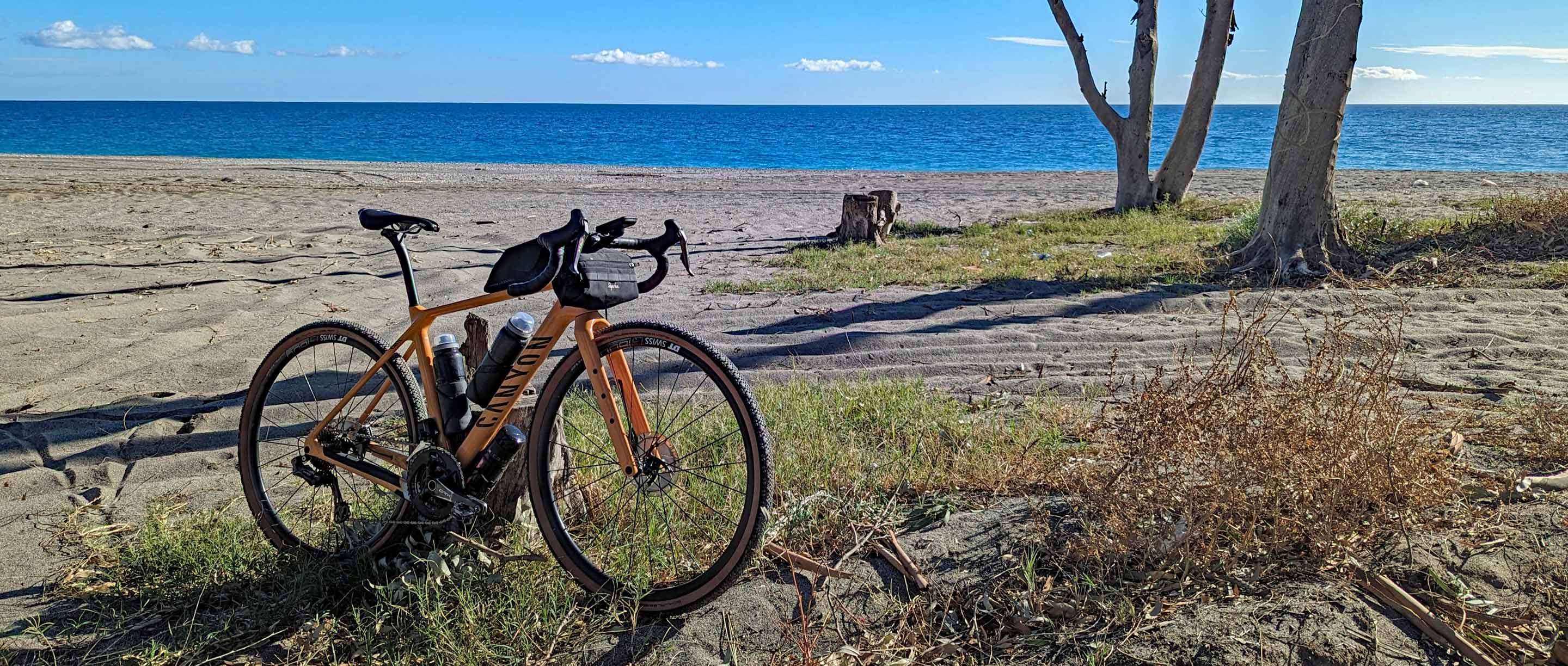
As described in the komoot tips, the trail by the beach was very sandy but if you chose the lines compacted by the few cars that took this route it was fairly easy to ride. I had a short stop at the beach to take in the sun and admire the waves and then it was onwards to my main destination for the day, Gole dell'Alcantara. It translates to Alcantara Gorges, named for how the Alcantara River has carved its way through the basalt, revealing stunning rock formations.

A casual internet search will tell you that there are two ways down to the gorges, one via a lift and the other taking the stairs, both with an entry fee. However, a free third route, mostly used by locals, is a slightly tricky walking path. By luck, this path can be accessed directly off a mountain biking trail and – never one to let the wrong kind of bike hold me back – I decided that I would investigate just how imperative it was to have a mountain bike. Well, it turns out the answer to that depends on your skill, strength and how far you're willing to hike your bike. A couple of hundred metres before and after the hiking path were beyond my ability, so I accepted a short walk. The hiking path down to the gorge was considerably overgrown and eroded, and the branches of a fallen tree also meant I had to crouch right down to pass one section. At this point, I was quite glad I'd opted to lock my bike to a wooden post at the start of the hike and not bring it with me. Ultimately it was well worth the hike because Gole dell'Alcantara is truly one of the most beautiful natural sights in Eastern Sicily.
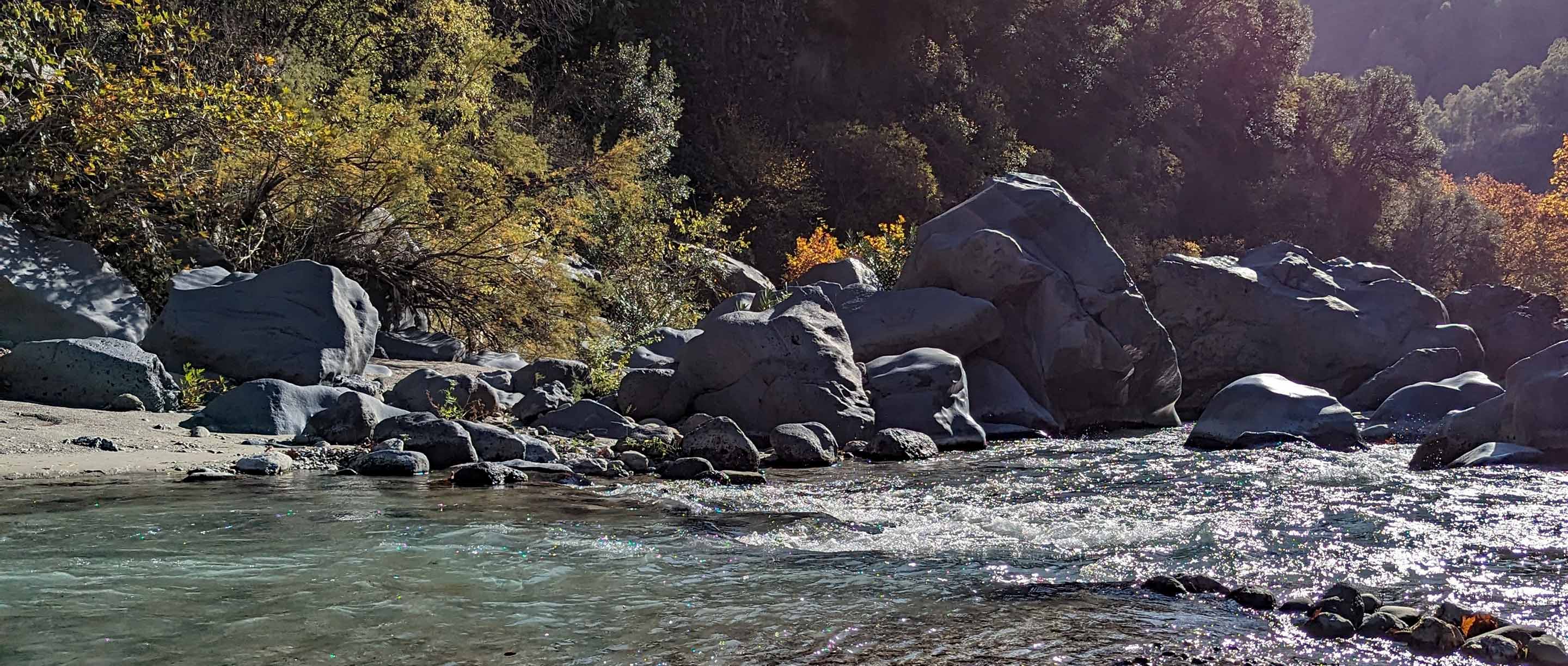
After around twenty minutes or so ambling around, I accepted that with limited daylight remaining, I'd have to carry on with the second half of my route. This would take me around various towns in the foothills of Etna. I could see the snowy mountaintop forming lenticular clouds in the distance and knew that I would be heading closer to it in the coming days.
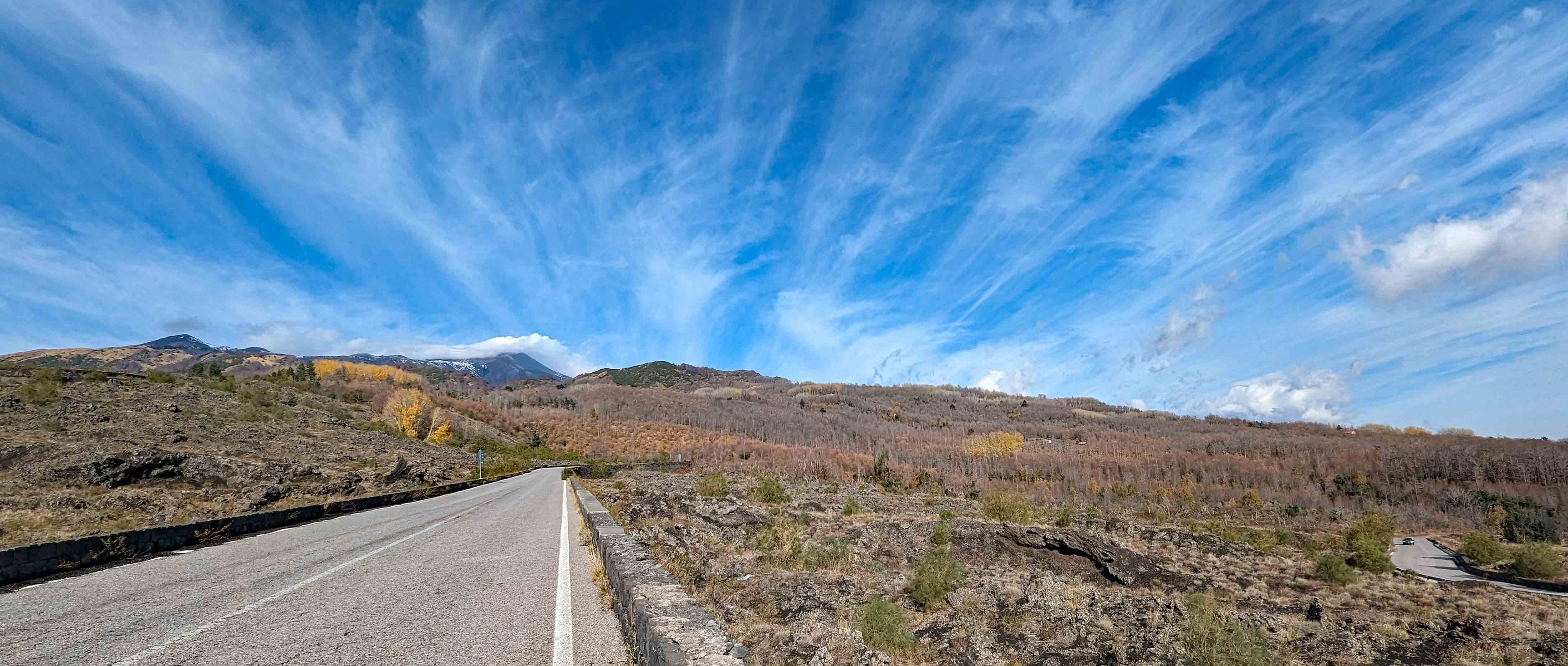
The temperature dropped dramatically the higher I climbed and the lower the sun fell, confirming to me that I'd have to bring the winter kit when I eventually headed straight up Etna, otherwise I might not survive the descents.
This time when I got back to my hotel, I didn't take a nap, I caught up on emails and started drafting this piece that you're reading now. I was hoping that it would result in a more restful night's sleep. Unfortunately, the next day I woke up feeling under the weather. But knowing my body well, I decided to head out for the day's ride anyway. Sure enough, minus a bit of sniffling, as soon as I was on the bike, everything felt fine.
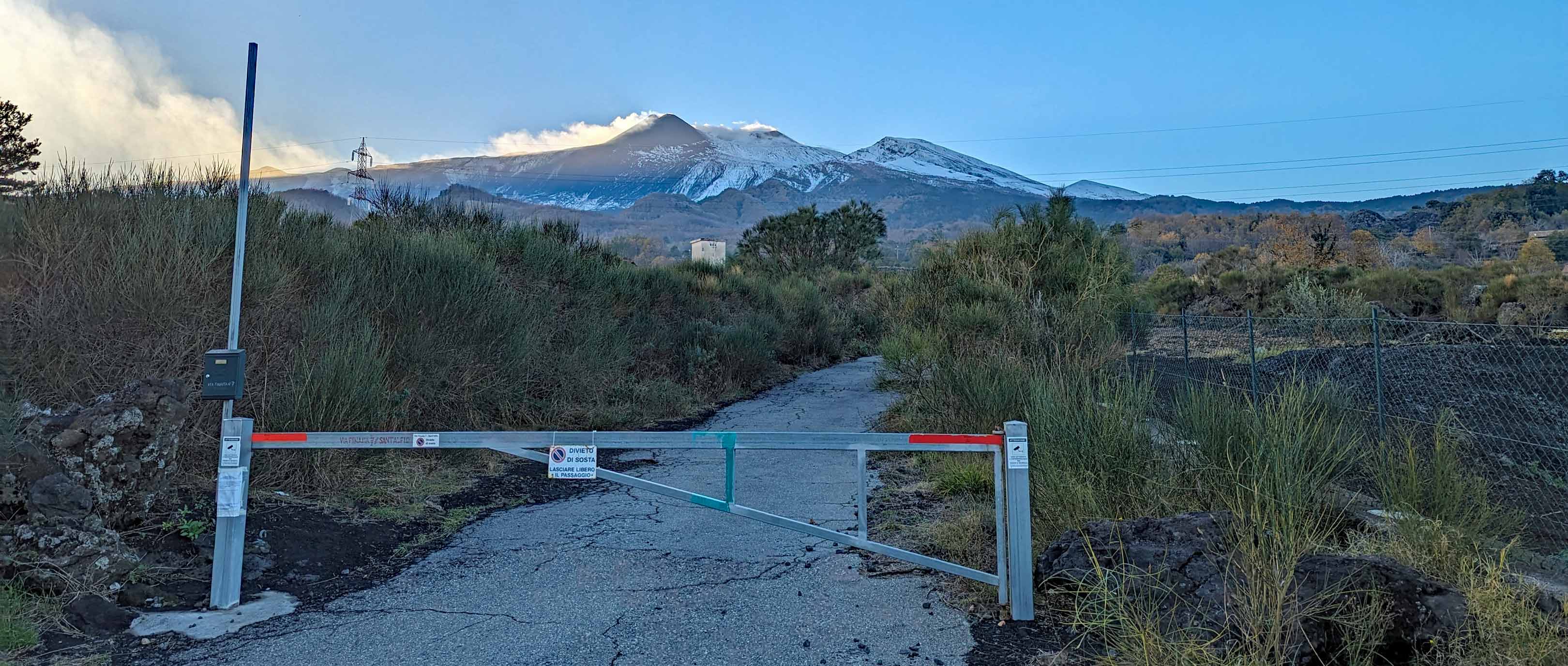
The second day of riding would take me up winding roads and gravel paths to Rifugio Citelli, a mountainside hotel and restaurant where I would lock up my bike again, change into hiking boots and a few more layers, and head off up the hiking trail to the Grotta di Serracozzo. The road climb was like anything you might come across in the Alps, with manageable ramps connected by switchbacks. It was when I finally turned off the road that things got interesting.
Many of the trails on Etna looked to be graded in MTB terms in komoot, so I made sure to stick to greens and blues when planning my route, as, from experience, these are typically fine for a gravel bike. What komoot doesn't exactly tell you, is that the trail surface is made of fine volcanic gravel that behaves like a mixture of slightly loose gravel and sand when you ride over it. Once you get accustomed to feeling a lot more movement under your tyres than you'd get on a typical well-compacted gravel trail, it becomes quite fun constantly switching lines and searching for more traction.

Just before I reached the top of the climb, which was also the location of Rifugio Citelli, the gravel path ended and I was back onto the road. Although the road looked far different than the one I had left behind many kilometres ago. Chunks of snow and ice littered the sides of the road, slowly melting in the midday sun. Just up ahead I could see the snowline, I would finally get my first taste of winter. I wondered if the kit I'd lugged up the mountain with me would be sufficient, I hadn't expected the snowline to be this low.
I locked my bike up at the Rifugio, swapped to my hiking boots, added an extra layer of socks, donned a merino hat, down jacket and my deep winter gloves, and off I went.
I very quickly began to wonder whether I'd made a mistake hiking this route in these weather conditions. The snow made the trail hard to spot, sometimes even obscuring the trail markers. Fortunately, the komoot app – coupled with the footprints of earlier hikers – gave me a reasonable level of confidence that I hadn't gone off course. There were some moments where eroded rock and icy patches had me considering whether I should turn back, but curiosity and determination generally got the better of me, so I pressed on.

Just as I was wondering how much longer it would be until I reached my destination, I saw a little signpost and immediately adjacent to this signpost was a small hole left behind by a lava tube. Knowing that that small hole was a significant part of the Grotta di Serracozzo, all that was left was to find the entrance. It took me about 10 minutes of wandering around in the snow until, just as I was about to give up, I spotted the entrance just below where I'd found the first hole.
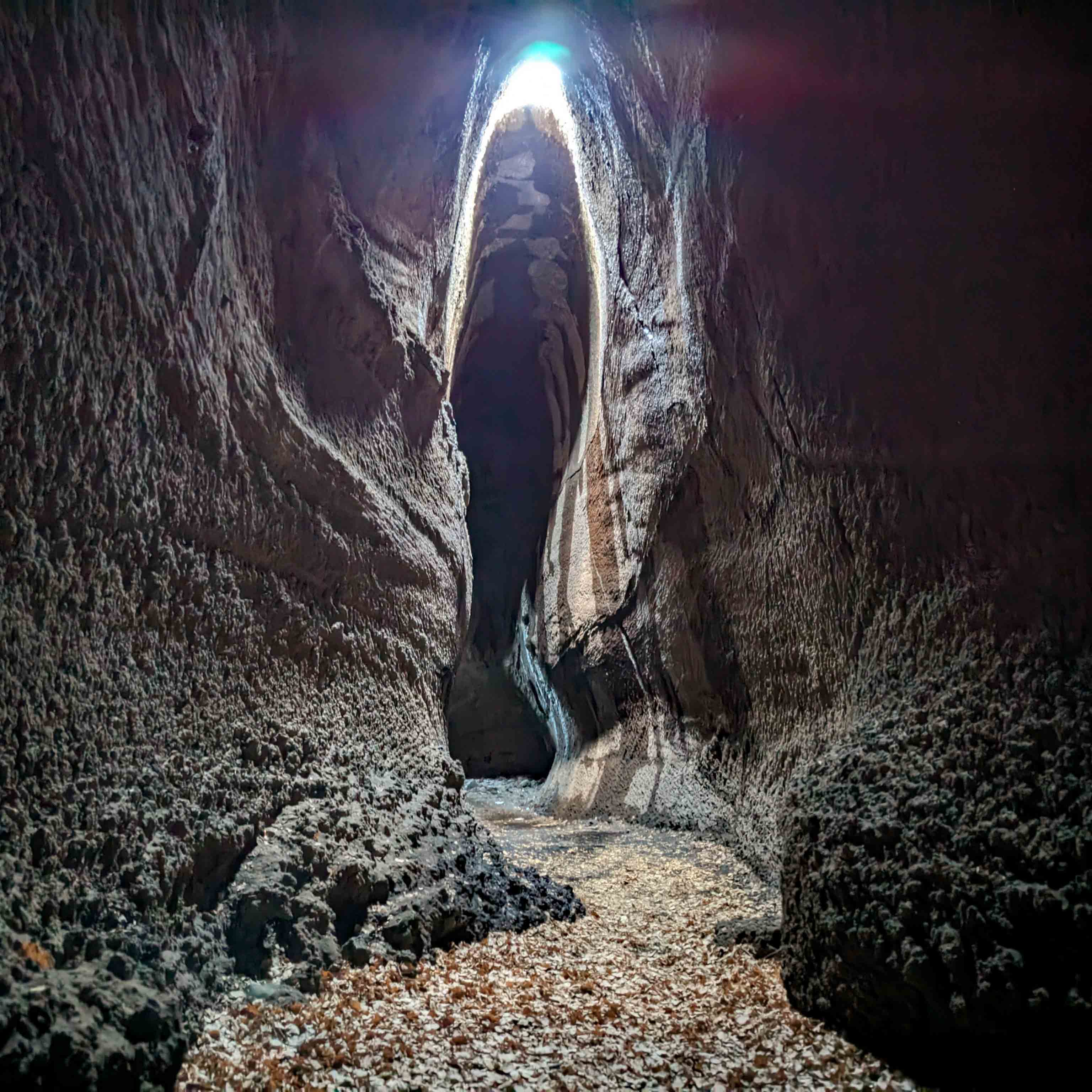
I cautiously entered the cave and I was immediately greeted by the view that makes the cave so popular, the “ghost” of Serracozzo. The light entering the cave from the hole I first spotted, is channelled into the cave in such a way that it creates a giant figure shrouded in a black cloak, a massive ethereal being.
I wanted to stay longer but I was concerned about both the remaining daylight and the tiny streams formed by the melting snow that I had hopped over on my way to the cave, they might have grown (but fortunately they had not).

I hurried back to the Rifugio and changed into my cycling kit, adding another jacket to brace against the biting wind on the descent. It was a lot of fun, zooming down the trails as fast as I dared, switching from side to side, always looking for firmer ground. The last section of the trail before reaching the road was composed of large basalt cobbles, it felt like it would rattle my bottles out of their cages, fortunately, it did not. However, I did find later on that it had rattled my multi-tool into many small pieces that I would then have to reconstruct.
I was then back onto the road and down a very fast and flowing tarmac descent, followed by a short 10% climb back to the hotel. A successful day of exploring the eastern side of Etna.
The next day my head cold had got substantially worse. I spent my time recuperating in the hotel, hoping that some extra time off the bike would allow me to have one more chance to climb the mountain.
And it worked! Thursday morning I was almost back to my usual self, definitely well enough to climb up to Rifugio Sapienza (of 2022 Giro d’Italia fame), but lacking the energy to do the full ride I had planned for the previous day, which would have been a full circuit of the mountain mostly at an altitude of approximately 1700m. Instead, my last-minute plan was to ride up to the Rifugio, catch the cable car up to 2500m and then test my skills at riding back down the gravel road back to the Rifugio.

Unfortunately, when I got to the cable car station it was not in operation, the only way up to 2500m was to either walk, ride it (absolutely not in the super strong winds that were the reason the cable car was closed) or on one of the 4x4 bus tours and I certainly couldn't bring my bike on those. My last-minute plan needed a last-second plan. I loaded the original circuit route onto my Hammerhead and gave myself approximately one hour to be back at the Rifugio – rain was forecast and the temperature with wind chill was close to freezing, so I didn't want to get caught in it.

I found my way onto a fun little trail in a very volcanic landscape. The gravel was similar to what I had found during my climb up to Rifugio Citelli, but coarser and looser, although still rideable. That's kind of my aim on trips like this - I generally pick MTB routes and see if they can be done on a gravel bike. So far, it's been quite successful. It's a shame I didn't get to do all the riding I had planned but sometimes that's how it goes.
I should also address the practicality of doing this trip in mid-December. A few locals commented that it wasn't the ideal time of year for a cycling trip, but my perspective is that if I always wait for the ideal conditions, there'd never be enough time for everything I want to do. When packing for this trip, I had it all - bibshorts and bibtights, short and long-sleeve jerseys, merino baselayers, summer mitts, winter boots. It was all necessary. My first ride was almost entirely in summer conditions, the other two varied between autumn and winter. The key thing is to be prepared and dress accordingly. From there, everything else can fall into place.
This trip was just a taste of one part of the island, and I would head back to Sicily in a heartbeat to continue the gravel exploration. But maybe next time, I’ll go in the spring or autumn, like a normal person, for the longer daylight hours if nothing else. This place deserves to be seen in its fullness rather than rushed through in the dead of night.
Dalila’s full collection of planned routes can be found below. If you want to try the ones she didn't manage, she requests that you let her know how you get on!